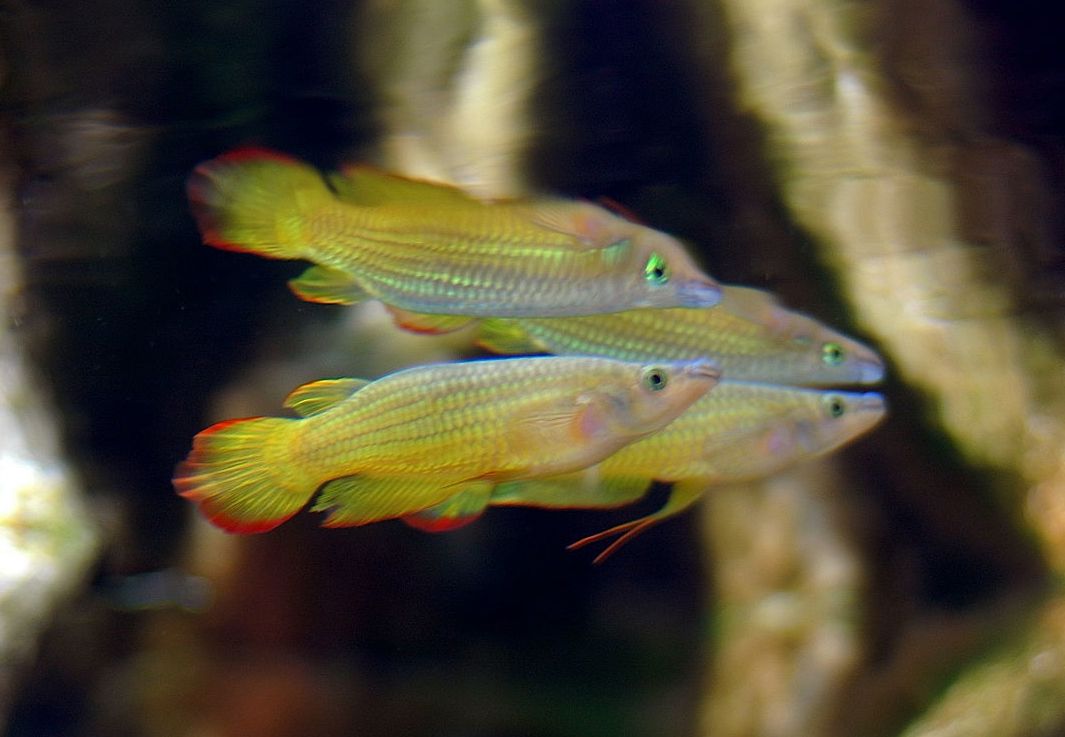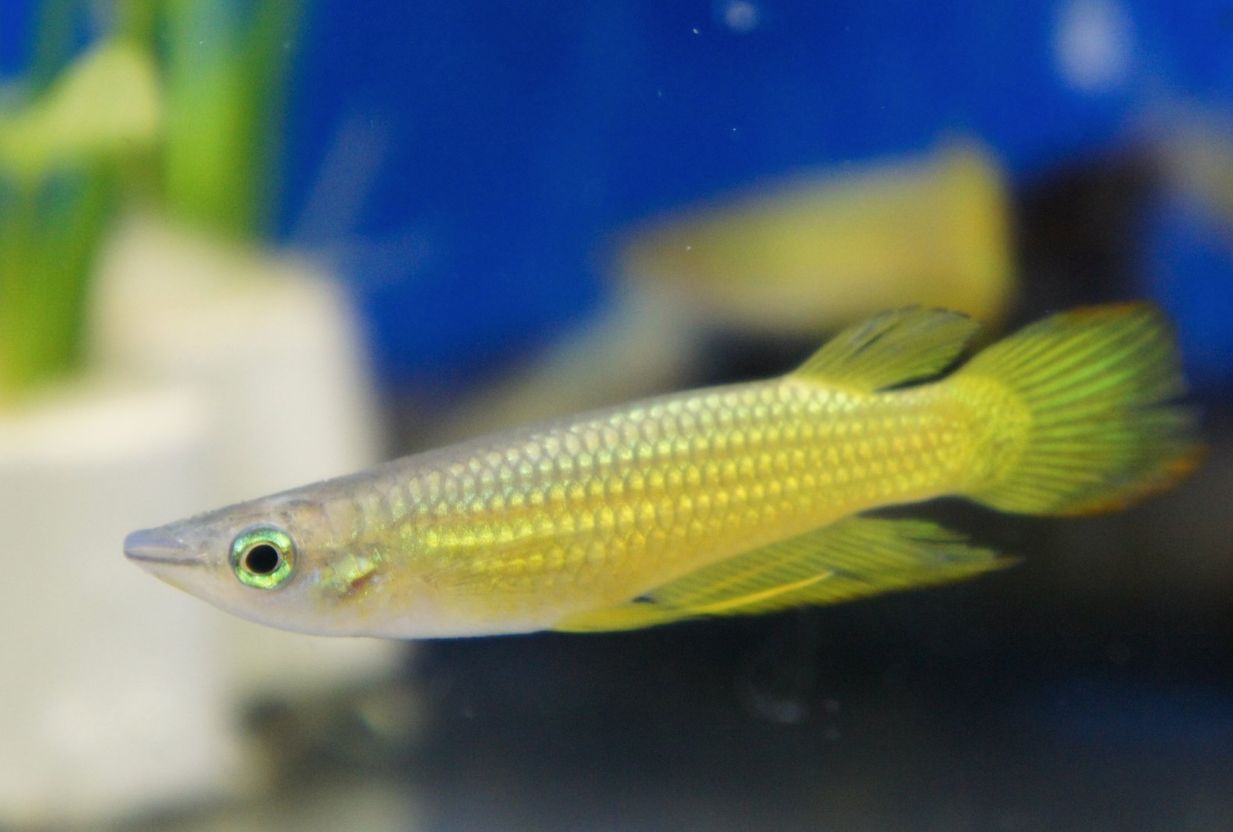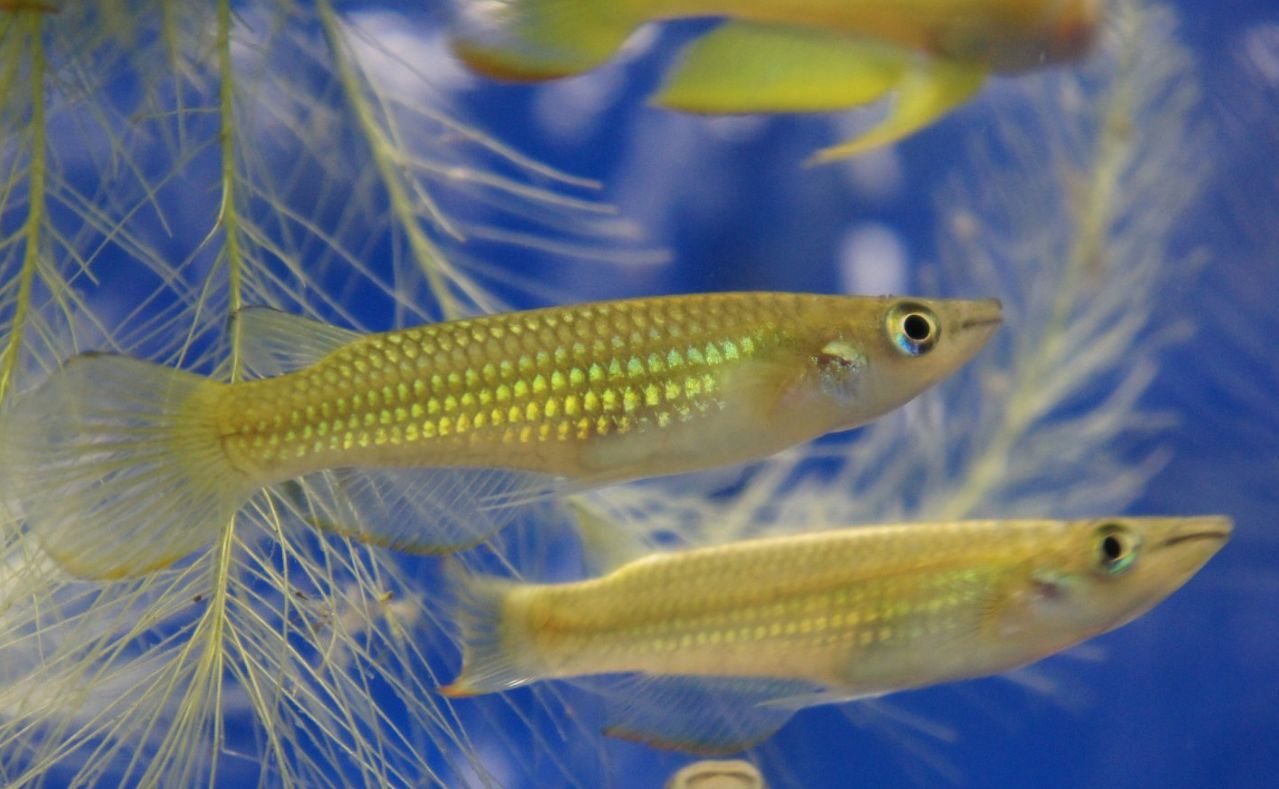The striped panchax is a popular tropical freshwater aquarium fish known for its striking appearance and adaptability. This species, found in the genus Aplocheilus, typically exhibits a bronze-colored body adorned with reddish fins and dark vertical stripes near the tail. Due to selective breeding, a stunning golden variant, known as the golden striped panchax, has emerged and gained popularity among aquarists. This vibrant version is now a favorite choice for both novice and experienced fish keepers due to its unique coloration and relatively easy care requirements.

Contents
Habitat in the wild
The striped panchax is a captivating species of freshwater fish from the family Aplocheilidae, commonly known as killifishes. This family includes small tropical and subtropical fish celebrated for their vibrant colors, diverse patterns, and intriguing breeding behaviors. Striped panchax, specifically, display a bronze-colored body with reddish fins and distinctive dark vertical stripes, making them visually appealing to aquarium enthusiasts. They are native to parts of South Asia, thriving in slow-moving or stagnant freshwater bodies like ponds, swamps, and ditches. Their striking appearance and lively behaviors, such as darting near the water’s surface, contribute to their popularity in home aquariums.
In their natural habitat, which spans regions of East India and has been introduced to Sri Lanka, striped panchax play a beneficial role in controlling mosquito populations. Locals often release these fish into small freshwater ponds near homes, where they consume mosquito larvae, thereby helping to reduce the insect population. They typically inhabit slowly flowing waters, bogs, flooded lowlands, and irrigation channels, preferring temperatures around 22 to 25 °C and a slightly acidic to neutral pH range of 6.5 to 7.5.
This species first appeared in home aquariums over a century ago, with successful breeding starting in Germany in 1909. The striped panchax has since proven to be a hardy aquarium fish, adapting well to a variety of tank conditions, including a minimum tank size of 10 gallons with plenty of swimming space.
They thrive in well-planted tanks with floating plants that mimic their natural environment, providing shelter and a sense of security. Additionally, their ease of breeding, often facilitated by providing spawning mops or fine-leaved plants, further enhances their appeal, making them a rewarding choice for both novice and experienced aquarists. Their peaceful temperament allows them to coexist well with other small, non-aggressive fish species, making them an excellent addition to community tanks.
Description
Size
The striped panchax typically grows to a length of about 3 inches (7.5 centimeters), making it relatively small. This size is one of the reasons they are favored by aquarium enthusiasts, as they can comfortably inhabit smaller tanks compared to larger fish species. Individual sizes can vary slightly, but a mature striped panchax will generally fall within this range.
Lifespan
In terms of lifespan, the average striped panchax lives around 2 to 3 years in captivity. However, this lifespan can fluctuate based on several factors, including the quality of care provided, the conditions of the aquarium environment, and the genetic health of the fish. With proper care and optimal conditions, some individuals may live longer.
Coloring
The striped panchax showcases a body that is gray with a greenish tint, darker on the top and marked with 4 to 6 black vertical stripes. This distinctive pattern is reflected in the fish’s name, “lineatus.” The fins match the body color but are slightly paler, with the anal and tail fins adorned with black edges of varying intensity. The elongated abdominal fins feature several rays that transform into thin filaments, enhancing their appearance.
Appearance Under Illumination
Under lateral illumination, the striped panchax exhibits a particularly appealing look; the scales of adult males shine with a bright green hue in reflected light. Therefore, it’s recommended to position the light source in a tank closer to the viewing glass to highlight this effect. The combination of the tall and long anal fin, alongside the dorsal and tail fins, forms a powerful blade that allows the fish to leap out of the water while hunting flying insects and to make abrupt directional changes underwater.
Color Variations
Currently, three color variations of the striped panchax are recognized: natural, golden, and red. The golden variation was discovered in 1993 among fish imported from the Goa province. Alongside naturally colored specimens, some golden-colored individuals were identified, quickly capturing the attention of aquarists. Compared to their natural counterparts, these golden striped panchax are noticeably brighter, with a main body color of golden-yellow and unpaired fins of the same hue. The initial breeding of these golden variants showed that this trait is inheritable, leading to their establishment in home aquariums.
The red color variation features males with a mix of greenish and olive-brown hues accented by a reddish tint. These fish are adorned with small, shiny, golden-green spots scattered across their sides, with prominent red spots on their chests. Each scale exhibits a large red spot, giving the impression that the fish’s body is sparkling.
| Characteristic | Description |
|---|---|
| Scientific Name | Aplocheilus lineatus |
| Common Name | Striped Panchax; panchax fish; striped panchax killifish; yellow panchax; golden wonder killifish |
| Family | Aplocheilidae |
| Habitat | Slow-moving or stagnant freshwater bodies |
| Native Range | South Asia (India, Sri Lanka, Bangladesh) |
| Size | Up to approximately 3 inches (7.5 centimeters) in length |
| Lifespan | Around 2-3 years in captivity |
| Behavior | Peaceful and relatively shy; may jump out of the water |
| Diet | Carnivorous, primarily feeds on small insects and worms |
| Temperature Range | 72°F to 82°F (22°C to 28°C) |
| pH Range | 6.0 to 7.5 |
| Water Hardness | Soft to slightly hard water (4-15 dGH) |
| Tank Size | Minimum 10-gallon tank for a small group |
| Tank Level | Middle to top, prefers floating or surface vegetation |
| Compatibility | Peaceful community fish, avoid aggressive tankmates |
| Breeding | Egg-scattering species; lay eggs among plants or moss |
| Special Considerations | Provide hiding spots, densely planted tanks |

Difficulties in keeping
Bright coloring, rather peaceful temper, and active behavior in a tank make wonder killifish desired in house ponds. Easy breeding and keeping conditions let us recommend them even for beginners to keep.
Care and keeping in a tank
Tank Size
It’s best to keep striped panchax in small groups, ideally with at least four individuals. The minimum recommended tank size for these fish is a 10-gallon tank, which can comfortably accommodate a small group of 3 to 4 striped panchax. However, a larger tank is always preferable, as it provides more swimming space and a more stable environment. Maintaining good water quality is essential, especially in smaller tanks, as they are more susceptible to fluctuations in water parameters.
If you plan to house other fish alongside the striped panchax, consider their compatibility and space requirements. Research the specific needs and behaviors of any additional species to ensure peaceful coexistence. To create a more natural and less stressful environment, include plenty of plants and hiding spots in the tank. Live plants help maintain water quality by absorbing excess nutrients and providing oxygen.
Avoid overcrowding, as it can lead to stress, aggression, and water quality issues. Aim to provide ample space for all fish to thrive. If possible, select the largest tank that fits your budget and available space to enhance the habitat for your striped panchax and any other fish.
Water Parameters
Water parameters are relatively flexible for striped panchax, which can thrive in both soft and hard water, preferably neutral or slightly acidic. The optimal tank conditions include:
- Temperature: 72°F to 82°F (22°C to 28°C)
- pH Level: 6.0 to 7.5
- Water Hardness (dGH): Soft to slightly hard water, ideally between 4 to 15 degrees German hardness (dGH)
Maintaining a stable water temperature within this range is crucial, as fluctuations can stress the fish and increase susceptibility to diseases. While striped panchax can adapt to a wide variety of temperatures, 24°C is considered optimal.
Regularly monitor the pH level, which measures the acidity or alkalinity of the water, to keep it within the preferred range. Water hardness, indicating the concentration of dissolved minerals, can vary, but staying within the specified range supports the health of the fish.
Conducting regular water tests is essential. If conditions are not within the recommended range, adjust them gradually to avoid stress. Regular water changes—aiming for weekly or bi-weekly—help remove accumulated pollutants and maintain water quality. By providing suitable water conditions, you can create a healthy environment for your striped panchax.
Tank Setup: Decorations and Plants
Striped panchax enjoy environments with plenty of cover, often staying near the water’s surface where potential prey is located. When housed in a species tank or with similarly sized, calm-tempered fish, they often swim in the middle or bottom water layers. They like to spend time among densely planted areas or gathering under large plant leaves. While not particularly timid, they will seek shelter among plants or under cover if threatened, turning to observe any potential danger.
A dark-colored substrate is preferable for these fish, with areas planted thickly and including driftwood or other natural decorations. Tank lighting should be kept dim, as striped panchax prefer lower light conditions. You can create this effect by using floating plants, such as water lettuce, or plants like Vallisneria that extend their leaves to the water’s surface.
Filtration
A reliable filter and heater are essential for maintaining a suitable environment for striped panchax. The filter keeps the water clean by removing debris and toxins, while the heater ensures the water remains at a comfortable temperature for the fish. By combining these elements with proper tank setup and water quality management, you can foster a thriving habitat for your striped panchax.
Diet
In the wild, the striped panchax is a predatory fish that cleverly waits under plant leaves, ready to strike at flying insects, their larvae, and small fish that venture into the upper water layers. This natural hunting behavior reflects their diet, which consists primarily of small, moving prey.
In an aquarium setting, striped panchax are not particularly demanding when it comes to food. They readily accept a variety of options, including live, frozen, and high-quality artificial foods. It’s crucial to carefully calculate the amounts you feed them, as these fish can easily overeat. Recommended food additives include bloodworms, flies, and other insects, which provide essential nutrients and keep their diet interesting.
To ensure optimal health and vibrant coloration, offer a varied diet that meets their nutritional needs. Feed them small portions multiple times a day, as their small stomachs are better suited for frequent feeding rather than one large meal. Overfeeding should be avoided, as it can lead to water quality issues and health problems. By managing their diet effectively, you can help maintain a healthy and thriving striped panchax.

Tank mates
Striped panchax is a predator, but it doesn’t mean you can’t keep it with other fishes. The most important thing you should consider when selecting its tank mates is that they shouldn’t be smaller than panchax killifish. Otherwise, sooner or later, they’ll become its prey.
For this reason, keeping it with cardinal tetra, celestial pearl danio, cherry barb, dwarf pencilfish, endler guppy, fancy guppy, and similar fishes is strictly not recommended. This fish treats its small-sized tank mates as potential prey, but they try to eat them only if very hungry. The rest of the time, it doesn’t pay much attention to them. However, considering its large mouth and ability to attack abruptly, the chance of a successful attempt to eat its tank mate is very high.
The way how striped panchax killifish chases small fishes has a lot of in common with how northern pike hunts: striped panchax freezes hiding under plants and waits for its prey to come as close as it can catch it in one move. When the potential prey becomes reachable, the fish curls its tail and then straightens it and attacks the prey.
You shouldn’t keep Aplocheilus lineatus with large cichlids (oscar fish, jaguar cichlid) that can easily swallow the young fish. Also, you should avoid any fan-tailed fish.
Large tank mates such as barbs (tiger barb, Odessa barb, denison barb, gold barb), large platy, swordtails, and mollies will be a good company for the fish. However, when putting very active fish together with striped panchax, ensure that the latter gets enough food.
Intraspecific conflicts are seldom the case, but you should keep the fish in groups with females prevailing there. Fights that occur between the males from time to time are more likely aimed to compete; thus, they won’t cause any serious injuries.
The fight between the males goes as follows: the rivals stay parallel to each other so that one fish’s head is against the other fish’s tail. Then they stretch their fins and stick out their gill covers, and their bodies start waving. The rival less successful during this exercise admits his defeat and leaves the duel place. The winner usually doesn’t haunt the defeated.
Gender Differences: Male vs. Female
In striped panchax, there are distinct differences between males and females, particularly in coloration and fin structure. Males boast more vibrant and appealing colors, displaying a rich palette of gray with bright green or golden highlights on their scales. Their fins are longer and more elongated, often exhibiting a striking coloration that enhances their overall appearance. In contrast, females have a more subdued coloration, primarily gray with some sparkling golden-bronze scales on their sides. Their fins are shorter and have a yellow-white hue, with unpaired fins appearing more rounded and featuring yellow-orange edges.
This less vibrant coloring in females serves a practical purpose in the wild, allowing them to blend seamlessly into their surroundings among vertical plant stalks and aquatic greenery. When stressed, females may exhibit a wide dark stripe along their bodies, which is especially noticeable in younger individuals.
Breeding
Breeding striped panchax, regardless of their color morphs, is relatively straightforward under the right conditions. With suitable bottom substrate and a well-maintained tank environment, these fish often lay eggs even in a community tank. To successfully rear the juveniles, it’s crucial to remove the substrate containing the eggs to an incubation tank.
A spawning tank with a capacity of about 20-30 liters and a water depth of approximately 10-15 cm is recommended. The water parameters for breeding should match those used for keeping the fish. It’s beneficial to include floating plants on the water surface, and small-leaved plants or synthetic filaments can serve as effective spawning substrates. To encourage spawning, adding softened water and slightly raising the temperature can help.
Spawning typically occurs among the thick vegetation in the tank. A female can lay several eggs each day, and it’s advisable to transfer them to the incubator immediately. A large female can produce up to 25 eggs daily, leading to an average of about 100 eggs within a week.
The breeding process can continue for several weeks, followed by a break of about 10-14 days. The eggs are transparent, measuring between 1.4 and 1.6 mm in diameter. After an incubation period of about two weeks, the eggs hatch. It’s important to note that adult fish may consume their juveniles, so providing adequate protection is essential.
The newly hatched fry are relatively large and can begin feeding on brine shrimp nauplii almost immediately. With a nutritious diet and regular water changes, the juveniles grow quickly, reaching approximately 1.5 cm in length by one month of age. At this point, sex differentiation becomes possible, as male fins will become elongated and sharpened, and their vibrant coloration begins to develop. Striped panchax reach their full coloration and reproductive size of 6-7 cm at around six months of age.